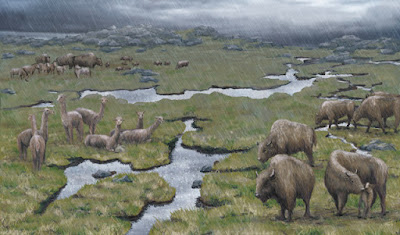It was 1984 on the Fain ranch near the headwaters of the Aqua Fria River when A. Jordan peered into a 13-foot deep arroyo and noticed a partial skeleton of a mammoth.
Soon, paleontologists from the Arizona Archeological Society, Yavapai College, Sharlot Hall Museum, and Northern Arizona University were busy unearthing the remains. Their work would also uncover the remains of three additional large mammals: a horse, a bison, and a camel.
The resulting study was titled “Late Pleistocene Mammalian Fauna From Prescott Valley, West-Central Arizona” by Michael R. Pasenko and Larry D. Agenbroad.
The specimens were found in Pleistocene sediments that dated back around 13,000 years ago. Interestingly, none of the finds were of mature adults. The camel and bison were juveniles, while the mammoth and horse were "sub-adult."
The time these animals were alive “is near the period established for Clovis-age humans, but no artifact was recovered at Fain Ranch,” the study explained, “which means Fain Ranch Locality is an example of a Clovis-age site without a known cultural association.”
Pleistocene fossils have been reported from several localities in Prescott Valley,” the study continued. These included a horse near Lynx Creek and several teeth of a mammoth on a ledge above Granite Creek.
“Excellent preservation of the [Fain ranch] mammoth indicated a rapid burial, and comparisons to other mammoths suggested the individual was a small male.” Although several mammoth bones were found, their “remains were disarticulated and scattered.” One full and several partial vertebrae, as well as several ribs, a femur, and a tusk, were unearthed.
 |
| Ancient Bison |
Bison behavior is such that if there was a juvenile there, there must have been an entire herd present.
The National Park Service offers this description of the animal: “The ancient bison, Bison antiquus, was taller, had longer horns, and was 25% more massive than living American bison (Bison bison). It was roughly 7.5 feet tall and 15 feet long, weighing approximately 3,500 pounds. Bison had bone horn cores on their skull that served as a base for a longer horn made of keratin, the protein that makes up our fingernails. The span of the horns of Bison antiquus was approximately 3 feet.”
 |
| Mexican horse |
The most mysterious of the findings was the camel. Although North America is hardly known for camels today, scientists believe that camelids originated here and migrated to Asia via the Bering Sea land bridge. Again, teeth were discovered. Unfortunately, teeth are very similar among camelids, making it impossible to discern which species it was.
 |
| A North American Camelid |
The fact that none of the finds were mature adults has caused some scientists to consider a “Clovis Age drought, discussed by C. V. Haynes (1991),” which occurred around the same time, as the possible culprit.
The findings of four large, herding, grazing mammals indicate that the grasslands must have been abundant in these parts, and there is evidence of ancient playa lakes around Lynx and the Aqua Fria creeks during that time.
Further findings have been unearthed elsewhere in Yavapai County. Indeed, “mammoths, mastodons, camels, and bison have been reported from a Pleistocene lake bed 3 km N [of the] M&M Mastodon Site (Hook, 1956; Morgan, 1996).”
But that’s another story for another day.
A list of the wild, edible fruits of Yavapai County; their traditional medicinal uses; and accompanying pictures.
**************************************
CLICK HERE for all the ARCHEOLOGY stories on #PrescottAZHistory!
**************************************
*********************************

Want more Prescott history? Join the "Celebrating Historic Prescott" group.
(Daily pics and featured articles.)
Drew Desmond is on Facebook (For the latest article and posts about Drew's writing.)






No comments:
Post a Comment